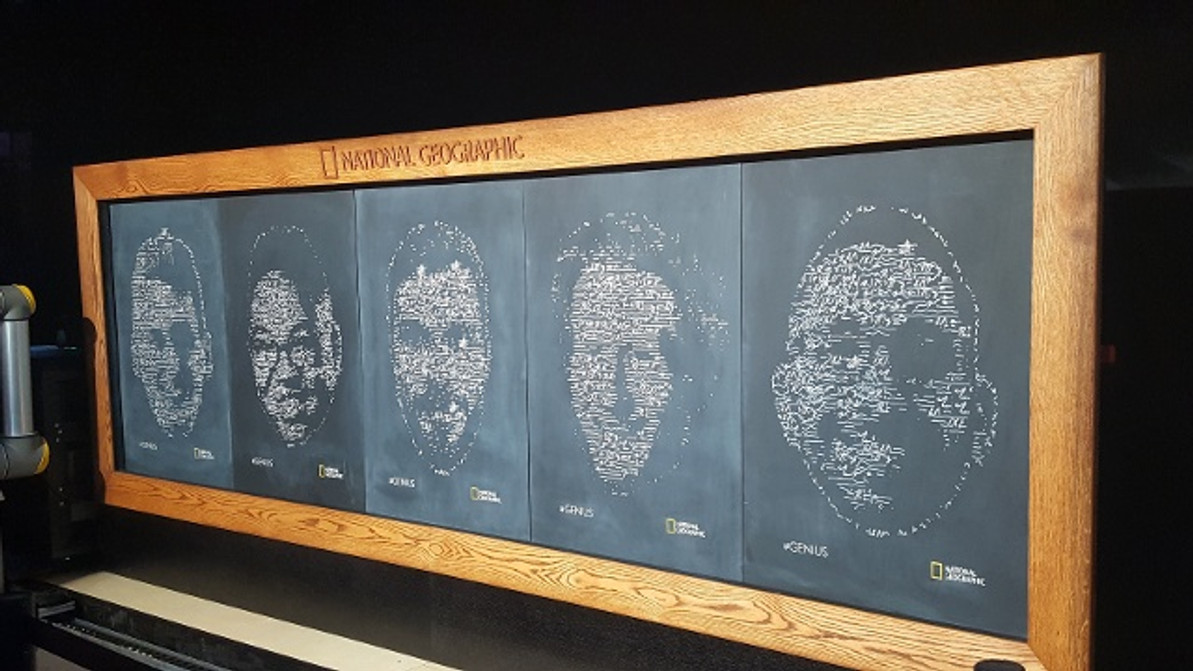Cobots Provide Plenty of Artistic License for Creative Applications: No “Genius” Required
This year’s SXSW festival in Austin, Texas featured a UR10 cobot in a show-stopping demo that highlights the robot’s creative capabilities. The demo was developed to help launch National Geographics’ new “Genius” TV series based on the life of Albert Einstein. People were invited to tweet a photo of themselves to a UR10 robot set up in front of a digital chalkboard. Using Einstein’s own handwriting, the cobot quickly began writing the inventor’s equations on the chalkboard, in seemingly random locations. It was only on stepping back from the chalkboard that the person’s portrait—made up entirely of equations—became clear. The robot’s speed and accuracy—as well as sophisticated programming capabilities—made the demo possible.

"This project was created in just 3 weeks,” said Kevyn McPhail, roboticist and integration engineer in Pennsylvania, who was commissioned by National Geographic to create the demo. “We really liked working with the UR robot. It was an incredibly fast process."
In developing this cutting-edge demo, the engineers received invaluable tech support from Universal Robot’s Tom Moolayil in the New York office. “The UR team really helped us push the application in ways it had not been pushed before,” said McPhail, who is now contemplating future UR robot projects.
The programming for the demo was done on a PC, using custom software made possible by the Universal Robots’ open interface SDK. This allows third parties to easily develop their own software tools for creative applications and make them available through the UR+ ecosystem. Once the photos were scanned and input to the computer as vector graphics, the program broke the image down into sequences that were streamed to the robot with ordered trajectories to trace the path. To maintain the surprise of the portrait emerging, the trajectories were deliberately sent in what looked like random order so that the demo appeared to be the robot simply writing equations—until the portrait was completed.
While this appears to be a one-of-a-kind application, it represents the powerful programming capabilities of the UR robots. While many cobots are implemented in repetitive applications such as machine tending or pick-and-place, new, more complex applications are emerging every day. Those may include changeable operations such as gluing or welding parts with different shapes and different required paths, which can be programmed similarly to this demo.
Einstein himself wrote in The Evolution of Physics: “To raise new questions, new possibilities, to regard old problems from a new angle requires creative imagination and marks real advances in science.”
This “genius” example using a Universal Robot shows just how possible those advances are.
Recent Posts
-
The Hidden Risk: Tampering with Safety Functions on Mobile Guards and How to Prevent It
In industrial environments, safety is not optional—it’s a critical necessity. Yet, despi …Feb 13th 2025 -
How Smart Automation is Solving Labor Shortages and Boosting Productivity in Warehouses
As labor shortages continue to challenge logistics, manufacturing, and distribution industries, mana …Feb 6th 2025 -
How Fabridor Embraced Robotics to Solve Quality Issues in Custom Cabinet Manufacturing
In Quebec, Canada, the custom kitchen cabinet manufacturer Fabridor faced a growing, albeit subtle, …Jan 30th 2025






